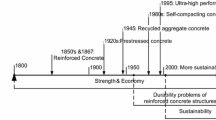Abstract
A new approach to the design of reinforced concrete (RC) structures is proposed. It does not rely on the traditional characteristic compressive strength of the concrete mix which is the basis of all current codes for the design of RC structures. Instead, the approach is based on the characteristic length of the concrete mix that has its origins in the concepts of fracture mechanics. Based on the research done in Cardiff University over the past 6 years on long and short beams and slender columns, it is shown that this new approach leads to a substantial reduction in the amount of reinforcing steel needed in RC structures made from high strength concrete mixes without jeopardising their ductility. This provides conclusive evidence that the current design code provisions for reinforcement based on the mix characteristic compressive strength grossly overestimate the requirements for high strength mixes leading to wastage of steel, reinforcement congestion and high cost of construction. The adoption of this new design approach, which is based on sound physical principles, should help promote the use of high performance, durable and sustainable concrete in the construction industry without increasing the cost of construction or compromising the safety of structures.



























Similar content being viewed by others
References
Abdalla HM, Karihaloo BL (2003) Determination of size-independent specific fracture energy of concrete from three-point bend and wedge splitting tests. Mag Concr Res 55:133–142
Bache HH (1986) Fracture mechanics in design of concrete and concrete structures. In: Wittmann FH (ed) Fracture toughness and fracture energy of concrete. Elsevier, Amsterdam, pp 577–586
Bosco C, Carpinteri A (1992) Fracture mechanics evaluation of minimum reinforcement in concrete structures. In: Carpinteri A (ed) Applications of fracture mechanics to reinforced concrete. Elsevier, London, pp 347–377
British Standard BS 1881–121:1983 (1983) Testing concrete: method of determination of static modulus of elasticity in compression. British Standards Institution, London
British Standard BS EN 12390–3:2009 (2009) Testing hardened concrete: compressive strength of test specimens. British Standards Institution, London
British Standard BS EN 12390–6:2009 (2009) Testing hardened concrete: tensile splitting strength of test specimens. British Standards Institution, London
Cifuentes H, Karihaloo BL (2013) Determination of size-independent specific fracture energy of normal- and high-strength self-compacting concrete from wedge splitting tests. J Constr Build Mater 48:548–553
Committee ACI 446 Report ACI 446–2R (1992) Fracture mechanics: application to concrete structures and implications with regard to the code. American Concrete Institute, Detroit
European Committee for Standardization (2004) ES EN 1992-1-1 Eurocode 2: design of concrete structures—part 1–1: general rules and rules for buildings. Brussels
Gougoulias S, Konstantinides N, Triantafyllidis I (2012) Design of RC beams based on the concrete mix characteristic length. MSc thesis, Cardiff University, UK
Hawkins NM (1985) The role of fracture mechanics in conventional reinforced concrete design. In: Shah SP (ed) Application of fracture mechanics to cementitious composites (NATO Advanced Research Workshop, Evanston, USA 1984). Martinus Nijhoff, Dordrecht, pp 639–666
Hawkins NM, Hjorteset K (1992) Minimum reinforcement requirements for concrete flexural members. In: Carpinteri A (ed) Applications of fracture mechanics to reinforced concrete. Elsevier, London, pp 379–412
Hillerborg A, Modeer M, Petersson PE (1976) Analysis of crack formation and crack growth in concrete by means of fracture mechanics and finite elements. Cem Concr Res 6:773–782
Karihaloo BL (1995) Fracture mechanics and structural concrete. Addison Wesley Longman, Harlow
Khan MZN, Wong C, Yan L (2009) Design of long RC beams based on concrete mix characteristic length. MSc thesis, Cardiff University, UK
Pei, Y, Rubel A, Yan T (2010) Design of short span RC beams based on the concrete mix characteristic length. MSc thesis, Cardiff University, UK
Qiu L, Zhang K (2013) Design of slender RC columns based on the concrete mix characteristic length. MSc thesis, Cardiff University, UK
Qureshi TS, Sagyndykov DT, Li X, Wahab F (2011) Reinforced concrete structure design based on concrete mix characteristic length. MSc thesis, Cardiff University, UK
Ramachandra Murthy A, Karihaloo BL, Iyer NR, Raghu Prasad BK (2013) Determination of size-independent specific fracture energy of concrete mixes by two methods. Cem Concr Res 50:19–25
Wei X (2007) Design of RC structures based on concrete mix characteristic length. MSc thesis, Cardiff University, UK
Acknowledgments
The work reported here would not have been possible without the enthusiastic and willing cooperation of my former MSc students, named in references 8–13. I am most grateful to all of them.
Author information
Authors and Affiliations
Corresponding author
Additional information
It had been planned to report this work for the first time at the 20th European Conference on Fracture (ECF20, Trondheim, July 2014) but that was not possible. However, a brief summary of some of the results that had been submitted to this Conference appears in Procedia Materials Science, Elsevier, vol 3, 2014, pp 369–377.
Rights and permissions
About this article
Cite this article
Karihaloo, B.L. A new approach to the design of RC structures based on concrete mix characteristic length. Int J Fract 191, 147–165 (2015). https://doi.org/10.1007/s10704-015-0009-2
Received:
Accepted:
Published:
Issue Date:
DOI: https://doi.org/10.1007/s10704-015-0009-2




